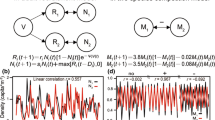Abstract
We present two frameworks for the description of traffic flow. First, we consider the coupling of a micro- and a macroscopic models, the former consisting in a system of ordinary differential equations and the latter in the usual LWR conservation law, see [5, 10]. Then, inspired by this model, we consider a macroscopic model where some trajectories are known thanks to, for instance, GPS measurement devices. The result is a new traffic model able to take into account real time data, or, in other words, that encodes these data, see [4]. This work follows a long collaborationwith RinaldoM. Colombo; the author thanks him for his support.
Similar content being viewed by others
References
N. Bellomo, A. Bellouquid, J. Nieto and J. Soler. On the multiscale modeling of vehicular traffic: From kinetic to hydrodynamics. Discrete Contin. Dyn. Syst. Ser. B, 19(7) (2014), 1869–1888.
N. Bellomo and C. Dogbe. On the modeling of traffic and crowds: a survey of models, speculations, and perspectives. SIAM Rev., 53(3) (2011), 409–463.
A. Bressan, S. Canic, M. Garavello, M. Herty and B. Piccoli. Flows on networks: recent results and perspectives. EMS Surv. Math. Sci., 1(1) (2014), 47–111.
R. M. Colombo and F. Marcellini. A traffic model aware of real time data. Mathematical Models and Methods in Applied Sciences, (2015), DOI: 10. 1142/ S0218202516500081, to appear.
R. M. Colombo and F. Marcellini. A mixed ODE-PDE model for vehicular traffic. Mathematical Methods in the Applied Sciences, 38 (2015), 1292–1302.
A. Klar and R. Wegener. Traffic flow: models and numerics. In “Modeling and computational methods for kinetic equations”, Model. Simul. Sci. Eng. Technol., pages 219–258. Birkhäuser (2004).
S. N. Kružhkov. First order quasilinear equations with several independent variables. Mat. Sb. (N. S.), 81(123) (1970), 228–255.
R. J. LeVeque. Numericalmethods for conservation laws. Lectures inMathematics ETH Zürich. Birkhäuser Verlag, Basel, second edition (1992).
M. J. Lighthill and G. B. Whitham. On kinematic waves. II. A theory of traffic flow on long crowded roads. Proc. Roy. Soc. London. Ser. A., 229 (1955), 317–345.
F. Marcellini. Free-congested andmicro-macro descriptions of traffic flow. Discrete Contin. Dyn. Syst. Ser. S, 7(3) (2014), 543–556.
B. Piccoli and A. Tosin. Vehicular traffic: a review of continuum mathematical models. Encyclopedia of Complexity and Systems Science. Springer, New York, 22 (2009), 9727–9749.
P. I. Richards. Shock waves on the highway. Operations Res., 4 (1956), 42–51.
Author information
Authors and Affiliations
Corresponding author
About this article
Cite this article
Marcellini, F. ODE-PDE models in traffic flow dynamics. Bull Braz Math Soc, New Series 47, 533–544 (2016). https://doi.org/10.1007/s00574-016-0167-5
Received:
Published:
Issue Date:
DOI: https://doi.org/10.1007/s00574-016-0167-5




